a-level化学课程大纲
- 格式:docx
- 大小:27.57 KB
- 文档页数:25

A-level-A2化学unit4部分内容整理Rate of reaction=change in concentration/rate , orrate=K[A]x[B]yK:the rate constant at a particular temperature[A]&[B]:the concentration of substances A & Bx:the order with respect to A, and y is the order for BThe overall order of reaction:the sun of the individual orders,x+yColorimetry measures the intensity of a color in a reaction mixture with time, such as in the oxidation of iodide ion to give brown iodine.In clock reaction the reaction is timed until a sudden color change happens when a certain amount of product is formed.Mass change is used when a gas is produced.Volume change is an alternative to mass changed for gases.Titrimetric analysis uses titrations to measure changing concentration of a reactant or product.HALF_LIFE:the time needed for any reactant concentration to fall to half of its.The diagram shows that the reaction is:*Exothermic- the products are at lower energy level than the reactants*Subject to an energy barrier, the activation energy in route 1*Able to follow an alternative pathway in route 2,with lower barrierA catalyst increase the reaction rate by proving an alternative reaction pathway with a lower activation energy.Catalyst and reactants can be in the same physical state, called homogenous.in different way,called heterogeneous.Process Reactants Catalyst Type of catalyst Haber synthesis Nitrogen,hydrogen Iron Heterogeneous Catalyst converter in carExhaust gases Platinum HeterogeneousConstant process,sulfuric acid manufacture Sulfur dioxide,oxygen gasesVanadiun(V) oxide HeterogeneousEsterification Solutions ofacid,alcoholHydrogen ions homogeneouslnK=-Ea/RT + a constantEa:the activate energy for the reactionR:the gas constant and has the value 8.31 JK-1mol-1T:the kelvin temperature (absolute temperature)Gradient=-Ea/Rrate=K[A][C]2the reaction is first order with respect to A- so A is involved in the rate-determining step the reaction is second order with respect to substance C-so moles of C are involved in the rate-determining stepR--I + OH-1*****R--OH + I-1S N2 mechanism,meaning substitution/nucleophilic/second orderThe slow step involves only one species and does not spend on the concentration of hydroxide ions.Rate=K[RI]The mechanism must be consistent with the evidence:*if the reaction is second order overall it must involve 2 different species.*if the reaction is first order overall (only 1 species in the rate equation) then this is the rate-determining step and it must be a 2-step reactionEntropy (symbol S) is a measure of disorder in a system.As the temperature of a material increases,the particles gain energy and their motion also increase.Higher temperatures, therefore,increase the disorder of the particles.Entropy increases with change of state to grater distance between particles and consequent increased disorderThe ions in solid sodium chloride are more ordered than the same ions dissolved in water.Dissolving sodium chloride causes the entropy to increase.Change Example Change in theentropy Reason for the changeReaction releasing a gas Zinc with sulfuricacid releasinghydrogenpositive (increasingentropy)Gas molecules aremore disorderedthan particles in thesolutionGas reaction where molecules combine,reducing the total number Haber process formaking ammoniaNegative Fewer productmolecules thanreactantmolecules,reducingthe disorderA standard entropy S is the entropy of a substance at standard temperature and pressure,and is expressed per mole of substance.The standard entropy change for physical or chemical processes is the difference in the entropies of the products and reactants measured under standard conditions:S[system]=S[product] - s[reactant]Spontaneous processes are often exothermic.Exothermic reactions give out heat(negative H),which increase the disorder of the surrounding particles.Some endothermic reactions are also spontaneous at room temperature.They have positive value for HWhether reactions occur spontaneously or not cannot be explained in terms of enthalpy changes alone.S[total]=S[system] +S[surrounding]For any spontaneous change S[total] must have a positive value.Total disorder must increase.S[surroundings]=-H/T (exothermic reactions have negative H but transfer energy to the surroundings,which increase their entropy.Change Exo/endothermic S[surroundings]S[system] S[total] why is thechangespontaneousDissolving sodium nitrite in water Endothermic Decrease Increasebecause thecrystallinelattice isdestroyed+ S[system] islargerSodium metal burning in Cl Exothermic Increase Decreasebecause acrystallinelattice isformed+ S[surroundings] is largerAmmonia gas and hydrogen chloride gas combine t give solid ammonium chloride Exothermic Increase decrease because alattice forms+ S[surroundings] is largerA feasible reaction has S[total]=S[system]- H/T*The entropy change in the system*The temperature measured in kelvin*The enthalpy change with the surroundings,HSpontaneous reactions can only happen for Stotal more than 0.A chemical reaction is feasible when S total has a positive value.Energy must first be provided to start such reactions*a spark*heat(as in the decomposition of CaCo3 above)*light (visible or UV)*lattice energy-the solid must separated into individual ions to dissolve (an endothermic change)*hydration enthalpy- the separated ions interact with the surrounding polar solvent,such as water (an exothermic change)H(solution)=-H(lattice energy) + H(hydration)A positive H(solution) corresponds to an overall endothermic change-dissolving is not favoured. It may still be favoured by an increase in entropy.Solid sodium chloride is a highly ordered 3-D lattice with a low entropy value.On dissolving,the ions separate and move independently,the entropy of the system therefore increases,favouring the change.A negative H(solution) corresponds to an overall exothermic change and so dissolving is favoured in term of enthalpy.The products have less energy than the reactants in general,although dissolving is regarded as a physical not a chemicalchange.The lattice enthalpy (or energy) of a compound is a affected by:1.the change on the ions---larger charges increase the force of attraction between oppositely charged ions2.the size of ions---smaller ions fit closer and this increase the force of attraction3.the degree of covalency in the ionic bonding---whether the bonding is 100% ionic and the ions completely separate, as the ionic model assumes.4.ionic radius---small ions have a great density5.ionic charge---larger charges increase the charge densityDynamic equilibrium:When both forward and reverse reaction in a reversible reaction continue but the rate of the forward reaction is equal to the rate of the reverse reaction:H2(s)+I2(s)=2HI(g)when hydrogen and iodine gases are first mixed in a closed system,the forward reaction alone begins since there are no products present.As the amounts of reactants fall,the forward rate decreases.Physical changes can also result in dynamic equilibria:I2(s)=I2(g)Important industrial reactions that are reversible include:*the Haber process for ammonia-N2(g)+3H2(g)=2NH3(g)*the contact process for sulfric acid-2SO2 (g) +O2 (g) =2SO3(g)*esterification -for example CH3COOH(I)+C2H5OH(I)=CH3COOC2H5(I)+H2O(I) Equilibrium law:There is a relationship between the reactant and the product equilibrium concentrations at a particular temperature.K c:the equilibrium constantHomogeneous:all liquids or all gases.Hetergeneous:more than 1 physical state is present.K c>>1:the products are favored,and the position of equilibrium lies well over to the product side.K c<<1:the reactant are favored,and the position of equilibrium lies well over to the reactant side.K c is very large indeed,such as 1×1010:the reaction has one to completion. K c is tiny,such as 1×10-10:NO reaction has occurred.。
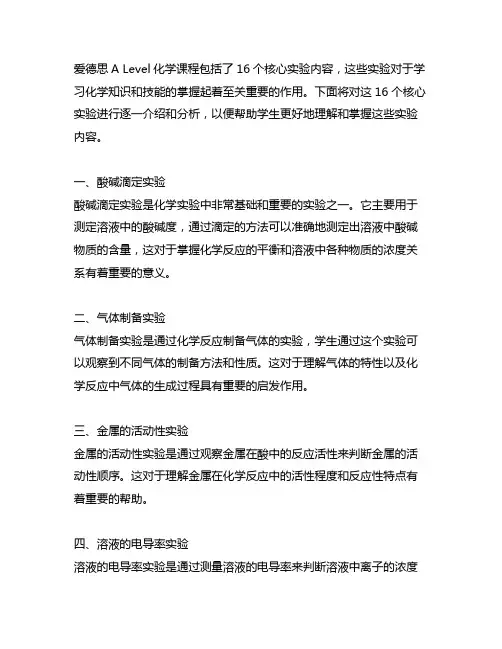
爱德思A Level化学课程包括了16个核心实验内容,这些实验对于学习化学知识和技能的掌握起着至关重要的作用。
下面将对这16个核心实验进行逐一介绍和分析,以便帮助学生更好地理解和掌握这些实验内容。
一、酸碱滴定实验酸碱滴定实验是化学实验中非常基础和重要的实验之一。
它主要用于测定溶液中的酸碱度,通过滴定的方法可以准确地测定出溶液中酸碱物质的含量,这对于掌握化学反应的平衡和溶液中各种物质的浓度关系有着重要的意义。
二、气体制备实验气体制备实验是通过化学反应制备气体的实验,学生通过这个实验可以观察到不同气体的制备方法和性质。
这对于理解气体的特性以及化学反应中气体的生成过程具有重要的启发作用。
三、金属的活动性实验金属的活动性实验是通过观察金属在酸中的反应活性来判断金属的活动性顺序。
这对于理解金属在化学反应中的活性程度和反应性特点有着重要的帮助。
四、溶液的电导率实验溶液的电导率实验是通过测量溶液的电导率来判断溶液中离子的浓度和种类,这对于理解溶液的电解质性质和离子在溶液中的导电特性有着重要的意义。
五、氧化还原滴定实验氧化还原滴定实验是一种重要的化学分析方法,通过观察氧化还原反应的行为和滴定的结果来进行化学物质的浓度测定和定性分析。
六、化合物的鉴定实验化合物的鉴定实验是通过化学反应和性质测定来鉴定化合物种类和结构的实验。
这对于学生理解化合物的性质和结构有着重要的启发作用。
七、有机化合物的合成实验有机化合物的合成实验是通过有机合成方法来合成和制备有机化合物,学生通过这个实验可以掌握有机化合物的合成原理和方法。
八、化学平衡实验化学平衡实验是通过观察化学反应平衡位置的移动和影响因素来研究化学平衡的规律和特性,这对于理解化学反应的平衡条件和动态平衡过程有着重要的帮助。
九、燃烧实验燃烧实验是通过观察不同物质的燃烧产物和反应过程来研究燃烧现象和燃烧规律,学生通过这个实验可以理解燃烧的化学过程和能量释放特性。
十、化学反应速率实验化学反应速率实验是通过观察化学反应速率的变化规律和影响因素来研究化学反应速率的规律和特性,这对于理解化学反应速率和反应动力学有着重要的启发作用。
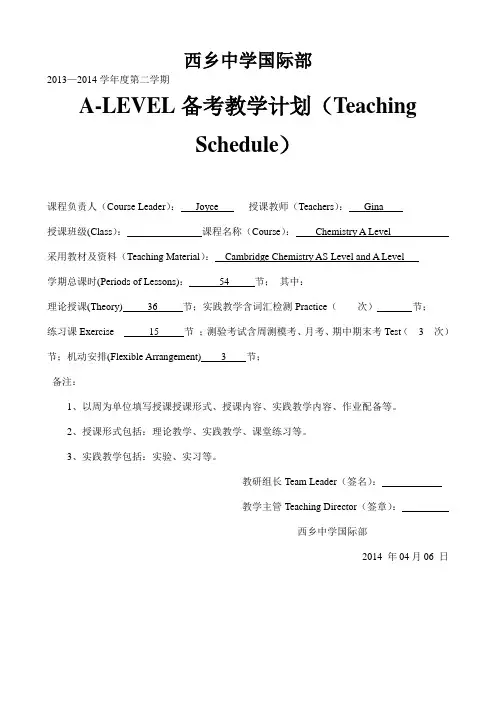
西乡中学国际部2013—2014学年度第二学期A-LEVEL备考教学计划(TeachingSchedule)课程负责人(Course Leader):Joyce 授课教师(Teachers):Gina授课班级(Class):课程名称(Course):Chemistry A Level采用教材及资料(Teaching Material):Cambridge Chemistry AS Level and A Level学期总课时(Periods of Lessons):54 节;其中:理论授课(Theory) 36 节;实践教学含词汇检测Practice(次)节;练习课Exercise 15 节;测验考试含周测模考、月考、期中期末考Test( 3 次)节;机动安排(Flexible Arrangement) 3 节;备注:1、以周为单位填写授课授课形式、授课内容、实践教学内容、作业配备等。
2、授课形式包括:理论教学、实践教学、课堂练习等。
3、实践教学包括:实验、实习等。
教研组长Team Leader(签名):教学主管Teaching Director(签章):西乡中学国际部2014 年04月06 日周次(Week)周学时(Hours)讲课内容、课时 (Content&Page)(写明章节、题目名称及页码)授课重难点及目标(Focus&Objective)讨论、习题、见习、实习、测试、考试(Exercise&Test)备注(Remarks)第 8 周 4自习天气原因测试Chapter1 Atomic structure(1)1.recognise and describle protons, neutrons andelectrons in terms of their relative charges andrelative masses;2.describle the contribution of protons andneutrons to atomic nuclei in terms of atomicnumber and mass number;3.deduce the number of protons, neutrons andelectrons present in both atoms and ions fromgiven atomic and mass number;4.describe the behavior of protons, neutrons andelectrons in electric field.Chapter1 Atomic structure(2)1.explain the terms first ioniation energy andsuccessive ionisation energies of an element interms of 1mol of gaseous atoms or ions;2.explain that ionisation energies are influencedby nuclear charge, atomic radius and electronshielding;3.predict the number of electrons in eachprincipal quantum shell of an element from itssuccessive ionisation energies;4. describe the shapes of s and p orbitals第 9 周 3 Chapter1 Atomic structure(3)1.describe the numbers and relative energies ofthe s, p and d orbitals for the principal quantumnumbers 1,2,3 and also the 4s and 4p orbitals.2.deduce the electronic configurations of atomsup to Z=36 and ions, given the atomic numberand charge, limited to s and p blocks up to Z=36习题课The key point of chapter 1Chapter2 Atoms, molecules andstoichiometry(1)1.define the terms relative atomic mass, relativeisotopic mass, ect, based on the 12C scale2.describe the basic principles f the massspectrometer3.intepret mass spectra in terms of isotopicabundnces4.calcuate the relative atomic mass of an elementgiven the relative abundances of its isotopes, orits mass spectrum5.define the mole in terms of Avgadro’s constantand molar mass as the mass of 1 mole of a substance第 10 周 3 Chapter2 Atoms, molecules andstoichiometry(2)1define the terms empirical formula andmolecular formula2.calcuate empirical formula and molecularformula, using composition by mass3.construct balanced chemical equations4.perform calculations involving reacting masses,volumes of gases and volumes andconcentrations of solutions in simple acid-basetitrations, and use those calculations to deducesstoichiometric relationships期中考试习题课The key point of chapter 2Chapter3 Chemical bonding andstructure(1)1.describe ionic bonding as the electrostaticattraction between two oppositely charged ions,including the use of dot-and-cross diagrams2.describe, in simple terms, the lattice structureof sodium chloride3.describe a covalent bond as a pair of electronsshared between two atoms4.describe, including the use of dot-and-crossdiagrams, covalent bonding and dative covalent(coordinate) bonding5.appreciate that, between the extremes of ionicand covalent bonding, there is a gradualtransition from one extreme to the other6.describe electronegativity as the ability of anatom to attract the bonding electrons in acovalent bond第 11 周 4Chapter3 Chemical bondingand structure(2)1.explain and predict the shapes of, and bondangles in, molecules and ions by using thequalitative model of 2.electron-pair repulsion upto 4 electrons pairs3.describe metallic bonding, present in a giantmetallic lattice structure, as the attraction of alattice of positive ions to sea of mobile electrons4.describe intermolecular force, based oninstantaneous and permanent dipoles5.describe, in simple terms, the giant molecularstructures of graphite and diamondChapter3 Chemical bonding andstructure(3)1.describe hydrogen bonding between moleculescontaining –OH and -NH groups, typified bywater and ammonia2.describe and explain the anomalous propertiesof water resulting from hydrogen bonding3.describe, interpret or predict physicalproperties in terms of the types, motion andarrangement of particles between them, anddifferent types of bonding4.deduce the type of bonding present in asubstance, given suitable information习题课The key point of chapter 3Chapter4 States of matter(1)1.describe, using a kinetic-molecular model, the solid, liquid and gaseous states, melting, vaporization and vapour pressure2.state the basic assumptions of the kinetic theory as applied to an ideal gas3.explain qualitatively, in terms of intermolecular forces and molecular size第 12 周 3 Chapter4 States of matter(2)1.state and use the ideal gas equation PV=nRT incalculations, including the determination of therelative molecular mass of a volatile liquid2.describe in simple terms lattice structures ofcrystalline solids which are ionic, simplemolecular, giant molecular, hydrogen-bonded ormetallic3.outline the importance of hydrogen bonding tothe physical properties of substancesChapter4 States of matter(3)1.describe and interpret the uses of aluminium,copper and their alloys in terms of their physicalproperties2.understand that materials are a finite resourceand that recycling processes are important3.suggest from quoted physical data the type ofstructure and bonding present in a substance 习题课The key point of chapter 4第 13 周 4 Chapter5 Chemical energies(1)1.explain that some chemical reactions areaccompanied by enthalpy changes, principally inthe form of heat energy. The enthalpy changescan be exothermic or endothermic2.recognize the importance of oxidation as anexothermic process3.recognize that endothermic processes requirean input of heat energyChapter5 Chemical energies(2)1.construct a simple enthalpy profile diagram fora reaction to show the difference in enthalpy ofthe reactants compared with that of the products2.explain chemical reactions in terms of enthalpychanges associated with the breaking and makingof chemical bonds3.explain and use the terms enthalpy change ofreaction, standard conditions and bond enthalpyChapter5 Chemical energies(3)1.calculate enthalpy changes from appropriate experimental results, including the use of the relationshipe Hess’s law to construct enthalpy cycles and carry out calculations using such cycles and relevant enthalpy terms习题课The key point of chapter 5第 14 周 4 Chapter6 Electrochemistry1.describe and explain redox processes in termsof electron transfer an of changes in oxidationstate2.explain, including the electrode reactions, theindustrial processes of the electrolysis of brine,using a diaphragm cell,ectChapter7 Equilibria(1)1.explain the features of a dynamic equilibrium2.state Le Chatelier’s principle and apply it todeduce qualitatively the effect of a change intemperature, concentration or pressure on ahomogeneous system in equilibriumChapter7 Equilibria(2)1.deduce, for homogeneous reactions,expressions for the equilibrium constants K C, interms of concentrations, and K P, in terms ofpartial pressures2.calculate the values of the equilibriumconstants K C or K P including determination ofunits, given appropriate data3.calculate a concentration or partial pressurepresent at equilibrium, given appropriate data Chapter7 Equilibria(3)1.describe and explain the conditions used in theHaber process and the Contact process asexamples of the importance of a compromisebetween chemical equilibrium and reaction ratein the chemical industry2.describe and use the Bronsted-Lowry theory ofacids and bases, to include conjugate acid-basepairs3.explain qualitatively, in terms of dissociation,the differences between strong and weak acidsand between strong and weak bases in terms ofthe extent of dissociation习题课The key point of chapter 71.describe qualitatively, in terms of collisiontheory, the effect of concentration changes on therate of a reaction2.explain why an increase in the pressure of agas, increasing its concentration, may increase第 15 周 4 Chapter8 Reaction kinetics(1)the rate of a reaction involving gases3.explain qualitatively, using the Boltzmanndistribution and enthalpy profile diagrams, whatis meant by the term activation energy4.describe qualitatively, using the Boltzmanndistribution and enthalpy profile diagrams, theeffect of temperature changes on the rate of areactionChapter8 Reaction kinetics(2)1.explain what is meant by a catalyst2.explain that, in the presence of a catalyst, areaction proceeds via a different route3.interpret catalytic behavior in terms of theBoltzmann distribution and enthalpy profilediagrams4.describe enzymes as biological catalysts whichmay have specific activity习题课The key point of chapter 8第 16 周 4 Chapter9 Chemical periodicity(1)1.describe the Periodic Table I terms of thearrangement of elements by increasing atomicnumber, in Periods showing repeating physicaland chemical properties2.classify the elements into s, p and d blocks3.describe qualitatively the variations in atomicradius, ionic radius, melting point in electricalconductivity of the elements4.explain qualitatively the variation in atomicradius and ionic radius5.interpret the variation in melting point and inelectrical conductivity in terms of the presence ofsimple molecular, giant molecular or metallicbonding in the elementsChapter9 Chemical periodicity(2)1.explain the variation in the first ionizationenergy2.describe the reactions, if any, of the elementswith oxygen, with chlorine and with water3.state and explain the variation in oxidationnumber of the oxides and chlorides4.describe the reactions of the oxides with water5.describe and explain the acid-base behavior ofoxides and hydroxides6.describe and explain the reactions of thechlorides with water1.suggest the types of chemical bonding presentin chlorides and oxides from observations oftheir chemical and physical properties2.predict the characteristic properties of anChapter9 Chemical periodicity(3)element in a given Group by using knowledge ofchemical periodicity3.deduce the nature, possible position in thePeriodic Table, and identity of unknown elementsfrom given information of physical and chemicalproperties习题课The key point of chapter 9第 17 周 2 Chapter10 Group II(1)1.describe and explain the trends in electronicconfigurations, atomic radii and ionizationenergies of the Group II elements2.interpret and make predictions from thechemical and physical properties of the Group IIelements and their compounds3.show awareness of the importance and use ofGroup II elements and their compounds, withappropriate chemical explanations4.describe oxidation and reduction in terms ofelectron transfer and changes in oxidation state端午+高考Chapter10 Group II(2)1. describe the redox reactions of the elementsMg to Ba with oxygen and water and explain thetrend in reactivity in terms of ionization energies2.describe the reactions of Mg, MgO and MgCO3with hydrochloric acid3.describe the behavior of Group II oxides withwater4.describe the thermal decomposition of thenitrates and carbonate of Group II elements第18周 4Chapter10 Group II(3)1.describe the thermal decomposition of CaCO3to form CaO and the subsequent formation ofCa(OH)2 with water2.describe lime water as an aqueous solution ofCa(OH)2 and state its approximate pH3.describe the reaction of lime water with carbondioxide forming CaCO3, and with excess carbondioxide, forming Ca(HCO3)2, as in hard water 习题课The key point of chapter 10Chapter12 Group VII(1)1.explain trend in the volatilities of chlorine,bromine and iodine in terms of van der Waals’forces2.describe the relative reactivity of the elementsCl2, Br2and I2in displacement reactions and3.explain this trend in terms of oxidizing powderdescribe and explain the reactions of theelements with hydrogen4.describe and explain the relative thermalstabilities of the hydrides and interpret these interms of bond enthalpiesChapter12 Group VII(2)1.describe the characteristic reactions of the Cl-, Br- and I-with aqueous silver ions followed by aqueous ammonia2.describe and explain the reactions of halide ions with concentrated sulphuric acid3.describe and interpret, in terms of changes in oxidation state, the reactions of chlorine with cold, dilute aqueous sodium hydroxide to form bleach and with hot aqueous sodium hydroxide4.explain the use of chlorine in water purification recognize the industrial importance and environmental significance of the halogens and their compounds第 19 周 4习题课The key point of chapter 12Chapter14 Nitrogen and sulphur(1)1.explain the lack of reactivity o f nitrogen2.describe the displacement of ammonia from itssalts3.outline the industrial importance of ammoniaand of nitrogen compounds derived fromammonia4.explain the environmental consequences of theuncontrolled5.explain why atmosphere oxides of nitrogen repollutants, including their use in the oxidation ofatmospheric sulphur dioxideChapter14 Nitrogen and sulphur(2)1.describe the formation of atmospheric sulphurdioxide from the combustion of sulphurcontaminated carbonaceous fuels2.describe the role of sulphur dioxide in theformation of acid rain and the environmentalconsequences of acid rain3.describe the main detail of the Contact processand outline the industrial importance of sulphuricacid4.describe the use of sulphur dioxide in foodpreservation习题课The key point of chapter 14Chapter15 Introduction to organicchemistry(1)1.interpret and use the terms nomenclature,molecular formula, general formula, structuralformula, displaced formula, skeletal formula,homologous series and functional groupe IUPAC rules for naming organiccompounds1.perform calculation, involving use of the moleconcept and reacting quantities, to determine the第 20 周 4 Chapter15 Introduction to organicchemistry(2)percentage yield of a reaction2.describe and explain structural isomerism incompounds with the same molecular formula butdifferent structural formulaeChapter15 Introduction to organicchemistry(3)1.interpret and use the term stereoisomerism interms of cis-trans and optical isomerism2.describe and explain cis-trans isomerism inalkenes, in terms of restricted rotation about adouble bond3.determine the possible structural and cis-transisomers of an organic molecule of givenmolecular formulaChapter15 Introduction to organicchemistry(4)1.explain the term chiral centre and identify anychiral centres in a molecule of given structuralformula2.understand that chiral molecules preparedsynthetically in the laboratory may contain amixture of optical isomers, whereas molecules ofthe same compound produced naturally in livingsystems will often be present as one opticalisomer only第 21 周 4习题课The key point of chapter 15根据实际情况安排实验课机动安排第22周 3 复习课Chapter 1—chapter 5期末考试复习课Chapter 6—chapter 9复习课Chapter 10—chapter 15。
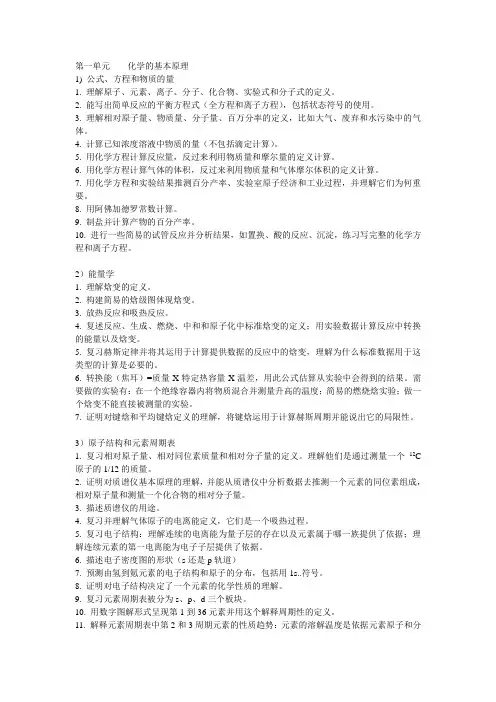
第一单元化学的基本原理1) 公式、方程和物质的量1. 理解原子、元素、离子、分子、化合物、实验式和分子式的定义。
2. 能写出简单反应的平衡方程式(全方程和离子方程),包括状态符号的使用。
3. 理解相对原子量、物质量、分子量、百万分率的定义,比如大气、废弃和水污染中的气体。
4. 计算已知浓度溶液中物质的量(不包括滴定计算)。
5. 用化学方程计算反应量,反过来利用物质量和摩尔量的定义计算。
6. 用化学方程计算气体的体积,反过来利用物质量和气体摩尔体积的定义计算。
7. 用化学方程和实验结果推测百分产率、实验室原子经济和工业过程,并理解它们为何重要。
8. 用阿佛加德罗常数计算。
9. 制盐并计算产物的百分产率。
10. 进行一些简易的试管反应并分析结果,如置换、酸的反应、沉淀,练习写完整的化学方程和离子方程。
2)能量学1. 理解焓变的定义。
2. 构建简易的焓级图体现焓变。
3. 放热反应和吸热反应。
4. 复述反应、生成、燃烧、中和和原子化中标准焓变的定义;用实验数据计算反应中转换的能量以及焓变。
5. 复习赫斯定律并将其运用于计算提供数据的反应中的焓变,理解为什么标准数据用于这类型的计算是必要的。
6. 转换能(焦耳)=质量X特定热容量X温差,用此公式估算从实验中会得到的结果。
需要做的实验有:在一个绝缘容器内将物质混合并测量升高的温度;简易的燃烧焓实验;做一个焓变不能直接被测量的实验。
7. 证明对键焓和平均键焓定义的理解,将键焓运用于计算赫斯周期并能说出它的局限性。
3)原子结构和元素周期表1. 复习相对原子量、相对同位素质量和相对分子量的定义。
理解他们是通过测量一个12C 原子的1/12的质量。
2. 证明对质谱仪基本原理的理解,并能从质谱仪中分析数据去推测一个元素的同位素组成,相对原子量和测量一个化合物的相对分子量。
3. 描述质谱仪的用途。
4. 复习并理解气体原子的电离能定义,它们是一个吸热过程。
5. 复习电子结构:理解连续的电离能为量子层的存在以及元素属于哪一族提供了依据;理解连续元素的第一电离能为电子子层提供了依据。
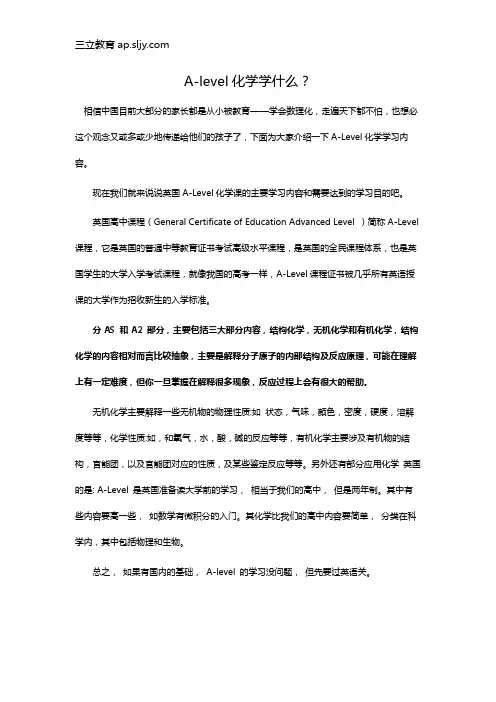
三立教育
A-level化学学什么?
相信中国目前大部分的家长都是从小被教育——学会数理化,走遍天下都不怕,也想必这个观念又或多或少地传递给他们的孩子了,下面为大家介绍一下A-Level化学学习内容。
现在我们就来说说英国A-Level化学课的主要学习内容和需要达到的学习目的吧。
英国高中课程(General Certificate of Education Advanced Level )简称A-Level 课程,它是英国的普通中等教育证书考试高级水平课程,是英国的全民课程体系,也是英国学生的大学入学考试课程,就像我国的高考一样,A-Level课程证书被几乎所有英语授课的大学作为招收新生的入学标准。
分AS 和A2 部分,主要包括三大部分内容,结构化学,无机化学和有机化学,结构化学的内容相对而言比较抽象,主要是解释分子原子的内部结构及反应原理,可能在理解上有一定难度,但你一旦掌握在解释很多现象,反应过程上会有很大的帮助。
无机化学主要解释一些无机物的物理性质:如状态,气味,颜色,密度,硬度,溶解度等等,化学性质:如,和氧气,水,酸,碱的反应等等,有机化学主要涉及有机物的结构,官能团,以及官能团对应的性质,及某些鉴定反应等等。
另外还有部分应用化学英国的是: A-Level 是英国准备读大学前的学习,相当于我们的高中,但是两年制。
其中有些内容要高一些,如数学有微积分的入门。
其化学比我们的高中内容要简单,分类在科学内,其中包括物理和生物。
总之,如果有国内的基础,A-level 的学习没问题,但先要过英语关。
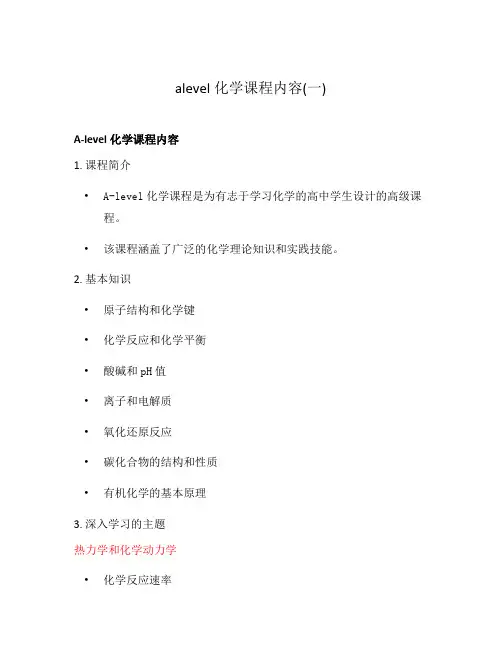
alevel化学课程内容(一)
A-level化学课程内容
1. 课程简介
•A-level化学课程是为有志于学习化学的高中学生设计的高级课程。
•该课程涵盖了广泛的化学理论知识和实践技能。
2. 基本知识
•原子结构和化学键
•化学反应和化学平衡
•酸碱和pH值
•离子和电解质
•氧化还原反应
•碳化合物的结构和性质
•有机化学的基本原理
3. 深入学习的主题
热力学和化学动力学
•化学反应速率
•化学平衡和Le Chatelier原理•熵和自由能变化
•反应的速率常数和反应机理
化学原理和实践
•元素周期表和元素的性质
•化学键的种类和性质
•化学实验技巧和安全措施
•精确测量和数据处理
有机化学
•烃和它们的衍生物
•反应机理和有机合成
•天然产物和医药化学
•聚合物和高分子材料
4. 实验和实践
•化学实验的设计和执行
•实验数据的收集和分析
•安全措施和实验室道德规范
•利用化学知识解决实际问题的实践技巧
5. 考试评估
•通过学生的课堂表现和课后作业来评估学习进展。
•定期进行模拟考试以检验学生对知识的理解程度。
•最终考试包括笔试和实验报告的评估。
6. 就业和职业选择
•化学领域的职业选择,如化学工程师、药剂师、研究科学家等。
•大学专业的选择和建议。
以上是一份关于A-level化学课程内容的简要介绍,通过深入学习基本知识和掌握实践技能,学生可以为进一步学习化学和从事与化学相关的职业打下坚实基础。
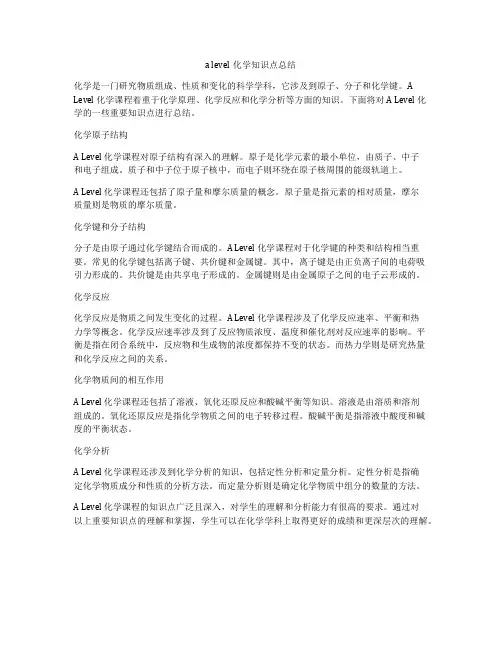
a level化学知识点总结化学是一门研究物质组成、性质和变化的科学学科,它涉及到原子、分子和化学键。
A Level 化学课程着重于化学原理、化学反应和化学分析等方面的知识。
下面将对 A Level 化学的一些重要知识点进行总结。
化学原子结构A Level 化学课程对原子结构有深入的理解。
原子是化学元素的最小单位,由质子、中子和电子组成。
质子和中子位于原子核中,而电子则环绕在原子核周围的能级轨道上。
A Level 化学课程还包括了原子量和摩尔质量的概念。
原子量是指元素的相对质量,摩尔质量则是物质的摩尔质量。
化学键和分子结构分子是由原子通过化学键结合而成的。
A Level 化学课程对于化学键的种类和结构相当重要。
常见的化学键包括离子键、共价键和金属键。
其中,离子键是由正负离子间的电荷吸引力形成的。
共价键是由共享电子形成的。
金属键则是由金属原子之间的电子云形成的。
化学反应化学反应是物质之间发生变化的过程。
A Level 化学课程涉及了化学反应速率、平衡和热力学等概念。
化学反应速率涉及到了反应物质浓度、温度和催化剂对反应速率的影响。
平衡是指在闭合系统中,反应物和生成物的浓度都保持不变的状态。
而热力学则是研究热量和化学反应之间的关系。
化学物质间的相互作用A Level 化学课程还包括了溶液、氧化还原反应和酸碱平衡等知识。
溶液是由溶质和溶剂组成的。
氧化还原反应是指化学物质之间的电子转移过程。
酸碱平衡是指溶液中酸度和碱度的平衡状态。
化学分析A Level 化学课程还涉及到化学分析的知识,包括定性分析和定量分析。
定性分析是指确定化学物质成分和性质的分析方法。
而定量分析则是确定化学物质中组分的数量的方法。
A Level 化学课程的知识点广泛且深入,对学生的理解和分析能力有很高的要求。
通过对以上重要知识点的理解和掌握,学生可以在化学学科上取得更好的成绩和更深层次的理解。
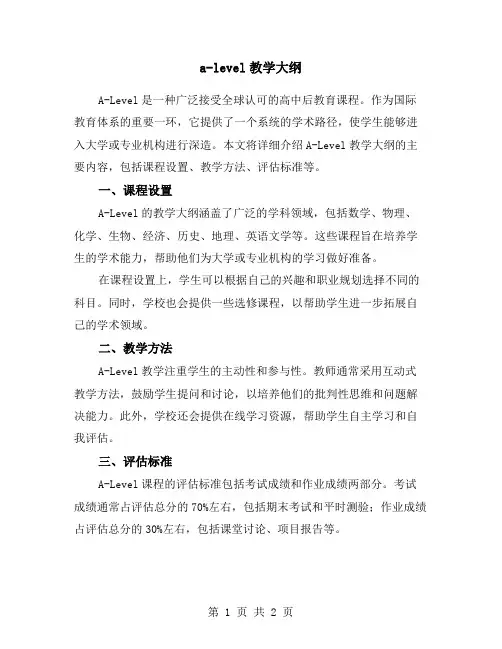
a-level教学大纲A-Level是一种广泛接受全球认可的高中后教育课程。
作为国际教育体系的重要一环,它提供了一个系统的学术路径,使学生能够进入大学或专业机构进行深造。
本文将详细介绍A-Level教学大纲的主要内容,包括课程设置、教学方法、评估标准等。
一、课程设置A-Level的教学大纲涵盖了广泛的学科领域,包括数学、物理、化学、生物、经济、历史、地理、英语文学等。
这些课程旨在培养学生的学术能力,帮助他们为大学或专业机构的学习做好准备。
在课程设置上,学生可以根据自己的兴趣和职业规划选择不同的科目。
同时,学校也会提供一些选修课程,以帮助学生进一步拓展自己的学术领域。
二、教学方法A-Level教学注重学生的主动性和参与性。
教师通常采用互动式教学方法,鼓励学生提问和讨论,以培养他们的批判性思维和问题解决能力。
此外,学校还会提供在线学习资源,帮助学生自主学习和自我评估。
三、评估标准A-Level课程的评估标准包括考试成绩和作业成绩两部分。
考试成绩通常占评估总分的70%左右,包括期末考试和平时测验;作业成绩占评估总分的30%左右,包括课堂讨论、项目报告等。
此外,学校还会采用其他评估方式,如教师评价、学生互评等,以全面评估学生的学习表现。
评估结果将为学生提供反馈和建议,帮助他们了解自己的优点和不足,以便及时调整学习策略。
四、未来展望随着全球教育体系的不断变革,A-Level教学大纲也在不断适应新的需求和挑战。
未来,学校将更加注重培养学生的创新能力和跨学科思维,以适应日益复杂和多元化的工作环境。
此外,学校还将加强与国际教育机构的合作,为学生提供更多出国留学和国际交流的机会,以拓宽他们的国际视野和跨文化沟通能力。
总的来说,A-Level教学大纲为学生提供了一个全面、系统的高中后教育课程,旨在帮助他们为大学或专业机构的学习做好准备。
通过精心设计的课程设置、灵活多样的教学方法和公正合理的评估标准,学校致力于培养出更多具有竞争力、创新能力和跨文化沟通能力的高素质人才。
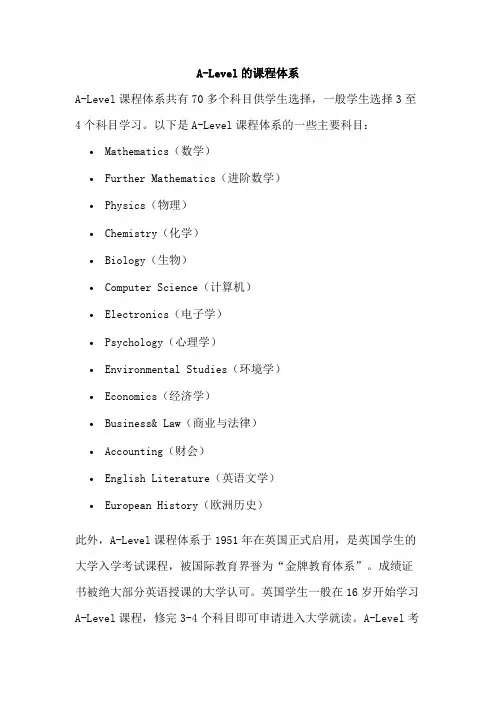
A-Level的课程体系
A-Level课程体系共有70多个科目供学生选择,一般学生选择3至4个科目学习。
以下是A-Level课程体系的一些主要科目:•Mathematics(数学)
•Further Mathematics(进阶数学)
•Physics(物理)
•Chemistry(化学)
•Biology(生物)
•Computer Science(计算机)
•Electronics(电子学)
•Psychology(心理学)
•Environmental Studies(环境学)
•Economics(经济学)
•Business& Law(商业与法律)
•Accounting(财会)
•English Literature(英语文学)
•European History(欧洲历史)
此外,A-Level课程体系于1951年在英国正式启用,是英国学生的大学入学考试课程,被国际教育界誉为“金牌教育体系”。
成绩证书被绝大部分英语授课的大学认可。
英国学生一般在16岁开始学习A-Level课程,修完3-4个科目即可申请进入大学就读。
A-Level考
试被称为“英国高考”,成绩是申请英国大学能否成功的决定因素。
同时,A-Level成绩在全世界100多个国家与地区得到认可,也可用于申请哈佛大学、耶鲁大学、多伦多大学、澳大利亚国立大学、悉尼大学、墨尔本大学、香港大学、香港科技大学、东京大学等英国本土以外的著名高等学府。
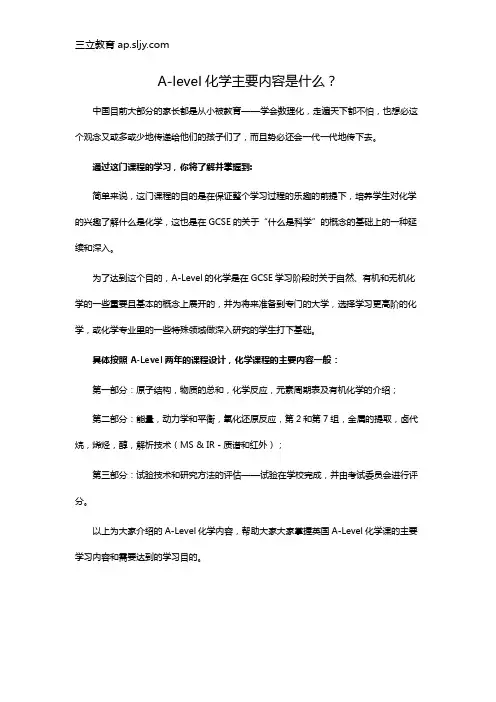
三立教育
A-level化学主要内容是什么?
中国目前大部分的家长都是从小被教育——学会数理化,走遍天下都不怕,也想必这个观念又或多或少地传递给他们的孩子们了,而且势必还会一代一代地传下去。
通过这门课程的学习,你将了解并掌握到:
简单来说,这门课程的目的是在保证整个学习过程的乐趣的前提下,培养学生对化学的兴趣了解什么是化学,这也是在GCSE的关于“什么是科学”的概念的基础上的一种延续和深入。
为了达到这个目的,A-Level的化学是在GCSE学习阶段时关于自然、有机和无机化学的一些重要且基本的概念上展开的,并为将来准备到专门的大学,选择学习更高阶的化学,或化学专业里的一些特殊领域做深入研究的学生打下基础。
具体按照A-Level两年的课程设计,化学课程的主要内容一般:
第一部分:原子结构,物质的总和,化学反应,元素周期表及有机化学的介绍;
第二部分:能量,动力学和平衡,氧化还原反应,第2和第7组,金属的提取,卤代烷,烯烃,醇,解析技术(MS & IR-质谱和红外);
第三部分:试验技术和研究方法的评估——试验在学校完成,并由考试委员会进行评分。
以上为大家介绍的A-Level化学内容,帮助大家大家掌握英国A-Level化学课的主要学习内容和需要达到的学习目的。
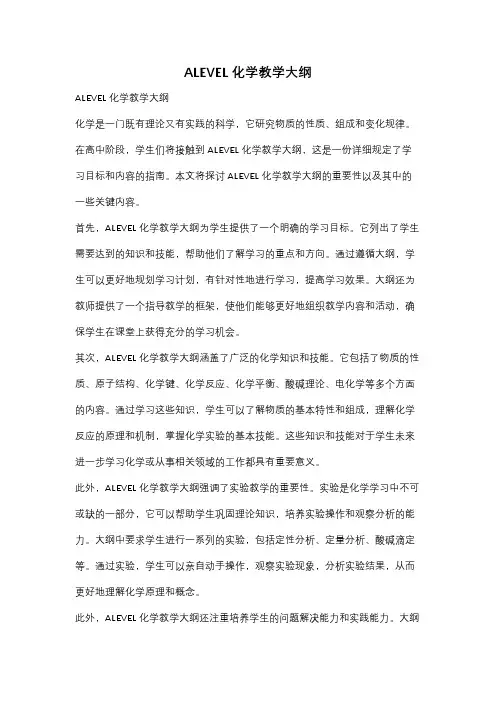
ALEVEL化学教学大纲ALEVEL化学教学大纲化学是一门既有理论又有实践的科学,它研究物质的性质、组成和变化规律。
在高中阶段,学生们将接触到ALEVEL化学教学大纲,这是一份详细规定了学习目标和内容的指南。
本文将探讨ALEVEL化学教学大纲的重要性以及其中的一些关键内容。
首先,ALEVEL化学教学大纲为学生提供了一个明确的学习目标。
它列出了学生需要达到的知识和技能,帮助他们了解学习的重点和方向。
通过遵循大纲,学生可以更好地规划学习计划,有针对性地进行学习,提高学习效果。
大纲还为教师提供了一个指导教学的框架,使他们能够更好地组织教学内容和活动,确保学生在课堂上获得充分的学习机会。
其次,ALEVEL化学教学大纲涵盖了广泛的化学知识和技能。
它包括了物质的性质、原子结构、化学键、化学反应、化学平衡、酸碱理论、电化学等多个方面的内容。
通过学习这些知识,学生可以了解物质的基本特性和组成,理解化学反应的原理和机制,掌握化学实验的基本技能。
这些知识和技能对于学生未来进一步学习化学或从事相关领域的工作都具有重要意义。
此外,ALEVEL化学教学大纲强调了实验教学的重要性。
实验是化学学习中不可或缺的一部分,它可以帮助学生巩固理论知识,培养实验操作和观察分析的能力。
大纲中要求学生进行一系列的实验,包括定性分析、定量分析、酸碱滴定等。
通过实验,学生可以亲自动手操作,观察实验现象,分析实验结果,从而更好地理解化学原理和概念。
此外,ALEVEL化学教学大纲还注重培养学生的问题解决能力和实践能力。
大纲中强调了学生需要进行独立思考和解决问题的能力。
学生需要通过分析问题,运用所学知识和技能,提出解决方案。
此外,大纲中还要求学生进行一定的研究项目,培养他们的实践能力和科学研究的意识。
这些要求旨在培养学生的创新思维和实践能力,为他们未来的学习和职业发展打下坚实的基础。
综上所述,ALEVEL化学教学大纲在高中化学教育中起着重要的作用。
alevel课程教材
A-Level是英国高中课程,其教材通常由专门的出版机构或教育机构出版。
以下是一些常见的A-Level课程教材:
数学:《A-Level数学》由英国剑桥大学出版,包括代数、几何、概率统计等方面的内容。
科学:《A-Level科学》由英国皇家化学会出版,包括生物化学物理地质材料科学等方面的内容。
商业学/经济学:《A-Level商业学/经济学》由英国爱德思国家学历与职业资格考试委员会出版,包括商业管理、市场营销、会计、经济学等方面的内容。
语言学:《A-Level语言学》由英国剑桥大学出版,包括语言结构、社会语言学、心理语言学等方面的内容。
艺术与设计:《A-Level艺术与设计》由英国牛津大学出版,包括绘画、雕塑、摄影、设计等方面的内容。
以上教材仅为常见的A-Level课程教材之一,具体使用哪种教材还需根据不同的学科和考试机构而定。
一、前言英国高中课程(General Certificate of Education Advanced Level)简称A-Level课程,是英国学生的大学入学考试课程,其地位等同于我国的高考。
该课程被誉为国际教育界的“金牌教育体系”,凭借该成绩的学生可以直接申请进入包括美国、加拿大、澳大利亚、新西兰和所有英联邦国家在内的全世界100多个国家和地区的正规大学学习,同时还可以直接报读我国香港、澳门地区的大学[1]。
因此,该课程受到了我国的外国语学校、普通高中国际部的青睐。
A-Level课程体系的课程标准、课程设置及其考试分别由英国四个主要考试局Cambridge International Examinations (CIE),Assessment and Qualifications Alliance(AQA),Oxford Cambridge and RSA Examinations(OCR)和ED⁃EXCEL等设计并组织,其权威性得到了国际上的广泛认可[2]。
本研究以英国Coordination Group Publica⁃tions(CGP)出版社于2015年出版的最新版AQA《A-Level Chemistry》教材[3]为研究对象,系统介绍该教材有机化学主题的内容选择及编排特点,为我国的外国语学校、普通高中国际部的化学教学提供参考,以期促进未来的课程和教材改革。
二、英国《A-Level Chemistry》教材简介英国CGP出版社的最新版AQA A-Level Chemistry 教材由物理化学(Physical Chemistry,9章)、无机化学(Inorganic Chemistry,4章)、有机化学(Organic Chemistry,9章)和实验技能四个版块,共计23章构成。
并且教材标注了AS考试内容(AS考试是学习A-Level课程第一年参加的考试,成绩合格会颁发AS证书)、A-Level考试内容,方便学习者针对性地选择课程内容。
a level有机化学
A-Level 有机化学是英国高中课程(General Certificate of Education Advanced Level)中的一门课程,主要涉及有机化合物的结构、性质、反应和合成等方面的知识。
以下是一些关于 A-Level 有机化学的详细解答:
1. 有机化合物的结构:A-Level 有机化学课程会介绍有机化合物的结构和命名方法,包括碳的成键方式、官能团的分类和命名、同分异构体的概念等。
2. 有机化合物的性质:课程会介绍有机化合物的物理性质和化学性质,包括熔点、沸点、溶解度、反应活性等。
3. 有机反应:课程会介绍各种有机反应类型,如取代反应、加成反应、消除反应、氧化还原反应等,并解释它们的反应机理和反应条件。
4. 有机合成:课程会介绍有机合成的基本原理和方法,包括反应选择、路线设计、保护基团的使用等。
5. 光谱学:课程会介绍光谱学在有机化学中的应用,包括红外光谱、紫外光谱、核磁共振光谱等。
A-Level 有机化学是一门非常有趣和具有挑战性的学科,需要学生具备良好的化学基础和逻辑思维能力。
alevel化学等第摘要:1.A-Level化学简介2.A-Level化学大纲内容3.A-Level化学考试形式和评分标准4.备考A-Level化学的建议5.A-Level化学对国内学生的意义正文:一、A-Level化学简介A-Level化学(Advanced Level Chemistry)是英国高中课程(A-Level)中的一门学科,适用于有志于进入大学学习化学、工程、生物学等相关专业的同学。
该课程旨在培养学生对化学基本概念、理论和实际应用的理解,为今后的学术和职业生涯奠定基础。
二、A-Level化学大纲内容A-Level化学大纲涵盖了广泛的主题,包括原子结构、化学键、化学计量、化学反应、有机化学、无机化学、物理化学等。
课程分为两个部分:1.核心内容:包括化学基本概念、化学键、化学反应、有机化学等。
2.选修内容:包括分析化学、环境化学、生物化学、材料化学等。
三、A-Level化学考试形式和评分标准1.考试形式:A-Level化学考试分为理论和实验两部分。
理论考试分为paper 1和paper 2,实验考试分为paper 3。
2.评分标准:A-Level化学总分为100分,其中paper 1和paper 2各占30%,paper 3占40%。
实验部分成绩分为五个等级:A、B、C、D、E,分别对应优秀、良好、及格、不及格和缺失。
四、备考A-Level化学的建议1.扎实掌握基础知识:化学基础知识是解决问题的关键,要加强基础知识的巩固。
2.大量练习:通过模拟试题、真题和专项练习,提高解题能力和应试技巧。
3.注重实验能力:实验部分占比较高,要加强实验操作和实验数据分析能力的训练。
4.合理安排时间:制定学习计划,合理分配各科目时间,确保化学学习效果。
五、A-Level化学对国内学生的意义1.提高综合素质:学习A-Level化学有助于提高学生的逻辑思维、分析问题和解决问题的能力。
2.拓宽留学方向:A-Level化学成绩可作为留学申请时的加分项,提高竞争力。
A-Level化学和高中化学1. 介绍在化学领域,A-Level化学和高中化学是两个重要的学术课程。
它们都涵盖了化学的基本概念、原理和实验技术。
这两个课程的目标是培养学生对化学的理解和应用能力,为他们在大学或职业生涯中打下坚实的基础。
2. A-Level化学2.1 课程内容A-Level化学是英国高中阶段的一门课程,通常在学生完成GCSE化学后进行学习。
该课程涵盖了广泛的化学知识和概念,包括有机化学、无机化学和物理化学等方面。
以下是一些常见的A-Level化学课程内容:•元素和化合物的性质•化学键和化学反应•酸碱平衡和氧化还原反应•离子反应和电解•化学动力学和平衡•化学能量和热力学•有机化学和功能性基团•分析化学和实验技术2.2 考试评估A-Level化学的考试评估通常分为两个部分:笔试和实验评估。
笔试包括多项选择题、填空题和解答题,以测试学生对化学概念的理解和应用能力。
实验评估则要求学生进行实验操作并记录结果,以评估他们的实验技能和数据分析能力。
3. 高中化学3.1 课程内容高中化学是中国高中阶段的一门必修课程,旨在培养学生对化学基础知识的理解和应用能力。
该课程内容包括以下方面:•基本化学概念和原理•元素和化合物的性质•化学键和化学反应•酸碱平衡和氧化还原反应•化学动力学和平衡•化学能量和热力学•有机化学基础•分析化学和实验技术3.2 考试评估高中化学的考试评估主要包括笔试和实验评估。
笔试内容包括选择题、填空题和解答题,以测试学生对化学知识的掌握和应用能力。
实验评估要求学生进行实验操作并记录结果,以评估他们的实验技能和数据分析能力。
4. 对比与联系A-Level化学和高中化学在课程内容和考试评估上有一些相似之处,但也存在一些差异。
4.1 课程内容对比A-Level化学相对于高中化学更加深入和广泛。
A-Level化学涵盖了更多的化学知识和概念,包括有机化学、无机化学和物理化学等方面。
高中化学则更注重基础知识的掌握和应用。
A-level化学和高中化学1. 简介化学是一门研究物质的组成、性质、变化以及与能量的关系的科学。
在高中阶段,学生们通常会接触到高中化学的基础知识,而在A-level阶段,学生们将进一步深入学习化学的各个领域,包括有机化学、无机化学、物理化学等。
2. 高中化学2.1 基础知识高中化学主要涉及以下几个方面的基础知识:•原子结构:学习原子的组成和结构,包括质子、中子和电子的概念,以及原子核、电子壳层等。
•元素周期表:了解元素周期表的结构和特点,包括元素的周期性和族性,以及元素的周期趋势。
•化学键:学习化学键的形成和类型,包括离子键、共价键和金属键等。
•化学反应:了解化学反应的基本概念,包括化学方程式的平衡、物质的摩尔比例等。
•酸碱中和反应:学习酸碱中和反应的原理和计算方法,以及酸碱指示剂的使用。
•氧化还原反应:了解氧化还原反应的基本概念和电子转移过程,以及氧化还原反应的应用。
•化学平衡:学习化学平衡的概念和平衡常数的计算,以及Le Chatelier原理的应用。
2.2 实验技能高中化学课程还注重培养学生的实验技能,包括以下方面:•实验操作:学习化学实验的基本操作技能,如称量、混合、加热等。
•实验设计:培养学生设计化学实验的能力,包括实验步骤、实验条件和实验控制等。
•数据处理:教授学生如何正确处理实验数据,包括数据的整理、图表的绘制和数据的分析等。
•安全意识:强调化学实验的安全性,教育学生正确使用实验器材和化学药品,以及遵守实验室安全规定。
3. A-level化学3.1 深入学习A-level化学相较于高中化学更加深入和细致,学生们将学习更多的化学理论知识和实验技能。
•有机化学:学习有机化合物的结构、命名和反应,包括碳骨架、官能团和取代反应等。
•无机化学:了解无机化合物的结构、性质和反应,包括离子反应、络合反应和配位化合物等。
•物理化学:深入学习化学的物理性质和化学动力学,包括化学平衡、速率方程和反应机理等。
第一单元化学的基本原理1)公式、方程和物质的量1. 理解原子、元素、离子、分子、化合物、实验式和分子式的定义。
2. 能写出简单反应的平衡方程式(全方程和离子方程),包括状态符号的使用。
3. 理解相对原子量、物质量、分子量、百万分率的定义,比如大气、废弃和水污染中的气体。
4. 计算已知浓度溶液中物质的量(不包括滴定计算)。
5. 用化学方程计算反应量,反过来利用物质量和摩尔量的定义计算。
6. 用化学方程计算气体的体积,反过来利用物质量和气体摩尔体积的定义计算。
7. 用化学方程和实验结果推测百分产率、实验室原子经济和工业过程,并理解它们为何重要。
8. 用阿佛加德罗常数计算。
9. 制盐并计算产物的百分产率。
10. 进行一些简易的试管反应并分析结果,如置换、酸的反应、沉淀,练习写完整的化学方程和离子方程。
2)能量学1. 理解焓变的定义。
2.构建简易的焓级图体现焓变。
3. 放热反应和吸热反应。
4. 复述反应、生成、燃烧、中和和原子化中标准焓变的定义;用实验数据计算反应中转换的能量以及焓变。
5. 复习赫斯定律并将其运用于计算提供数据的反应中的焓变,理解为什么标准数据用于这类型的计算是必要的。
6. 转换能(焦耳)=质量X特定热容量X温差,用此公式估算从实验中会得到的结果。
需要做的实验有:在一个绝缘容器内将物质混合并测量升高的温度;简易的燃烧焓实验;做一个焓变不能直接被测量的实验。
7. 证明对键焓和平均键焓定义的理解,将键焓运用于计算赫斯周期并能说出它的局限性。
3)原子结构和元素周期表1. 复习相对原子量、相对同位素质量和相对分子量的定义。
理解他们是通过测量一个12C原子的1/12的质量。
2. 证明对质谱仪基本原理的理解,并能从质谱仪中分析数据去推测一个元素的同位素组成,相对原子量和测量一个化合物的相对分子量。
3. 放热反应和吸热反应。
4. 复述反应、生成、燃烧、中和和原子化中标准焓变的定义;用实验数据计算反应中转换的能量以及焓变。
5. 复习赫斯定律并将其运用于计算提供数据的反应中的焓变,理解为什么标准数据用于这类型的计算是必要的。
6. 转换能(焦耳)=质量X特定热容量X温差,用此公式估算从实验中会得到的结果。
需要做的实验有:在一个绝缘容器内将物质混合并测量升高的温度;简易的燃烧焓实验;做一个焓变不能直接被测量的实验。
7. 证明对键焓和平均键焓定义的理解,将键焓运用于计算赫斯周期并能说出它的局限性。
3)原子结构和元素周期表1. 复习相对原子量、相对同位素质量和相对分子量的定义。
理解他们是通过测量一个12C原子的1/12的质量。
2. 证明对质谱仪基本原理的理解,并能从质谱仪中分析数据去推测一个元素的同位素组成,相对原子量和测量一个化合物的相对分子量。
描述质谱仪的用途。
4. 复习并理解气体原子的电离能定义,它们是一个吸热过程。
5. 复习电子结构:理解连续的电离能为量子层的存在以及元素属于哪一族提供了依据;理解连续元素的第一电离能为电子子层提供了依据。
6. 描述电子密度图的形状(s还是p轨道)7. 预测由氢到氪元素的电子结构和原子的分布,包括用1s..符号。
8. 证明对电子结构决定了一个元素的化学性质的理解。
9. 复习元素周期表被分为s、p、d三个板块。
10. 用数字图解形式呈现第1到36元素并用这个解释周期性的定义。
11. 解释元素周期表中第2和3周期元素的性质趋势:元素的溶解温度是依据元素原子和分子之间的结构和键的数据,4)键1. 离子键:复习并说明存在的离子的依据,受限于离子化合物的物理性质、电子密度图以及电子迁移;根据电子的得与失描述离子的形成;用点叉电表电子画出阴离子和阳离子的电子分布图;描述离子晶体是巨大的晶格离子;描述离子键是离子之间强大的净静电吸引的结果;复习在一族中离子半径的趋势(一系列等电子离子,N3-到Al3+);复习从元素中形成一个固体的离子晶体的步骤(学生不需要画整个波恩-哈勃循环);测试一个特定化合物离子模型的离子键;解释极化的定义;理解一个阳离子的极化性是依据它的半径和电极,阴离子是依据它的大小;阴阳离子的极化会导致一个离子键的某些共价;用在波恩-哈勃循环基础上计算出的标准生成热,解释为什么有一些特殊的离子化合物的存在。
2. 共价键:理解共价键是很强的,是在原子核和电子之间的静电吸引中产生的,依据是巨大原子结构的物理性质和简单分子的电子密度图;画出简单共价分子的电子分布图。
3.金属键:理解金属是由电子海中巨大的金属离子晶格组成的;金属键是金属离子和自由电子间的强相互作用产生的;以1.6.3a和1.6.3b为模型说明金属的简单性质子之间的结构和键的数据,4)键1.离子键:复习并说明存在的离子的依据,受限于离子化合物的物理性质、电子密度图以及电子迁移;根据电子的得与失描述离子的形成;用点叉电表电子画出阴离子和阳离子的电子分布图;描述离子晶体是巨大的晶格离子;描述离子键是离子之间强大的净静电吸引的结果;复习在一族中离子半径的趋势(一系列等电子离子,N到Al3+);复习从元素中形成一个固体的离子晶体的步骤(学生不需要画整个波恩-哈勃循环);测试一个特定化合物离子模型的离子键;解释极化的定义;理解一个阳离子的极化性是依据它的半径和电极,阴离子是依据它的大小;阴阳离子的极化会导致一个离子键的某些共价;用在波恩-哈勃循环基础上计算出的标准生成热,解释为什么有一些特殊的离子化合物的存在。
共价键:理解共价键是很强的,是在原子核和电子之间的静电吸引中产生的,依据是巨大原子结构的物理性质和简单分子的电子密度图;画出简单共价分子的电子分布图。
3.金属键:理解金属是由电子海中巨大的金属离子晶格组成的;金属键是金属离子和自由电子间的强相互作用产生的;以1.6.3a和1.6.3b为模型说明金属的简单性质5)有机化学简介1.理解一系列有机化学物的特征是用基本分子式表达。
烷烃:写分子式;理解烷烃是仅含有单键的饱和碳氢化合物;以烷烃为例(最多到C5)解释结构异构体的存在;理解烷烃被用于燃料,通过原油的分馏提炼,分裂和重组提取;讨论开发可替代能源的原因;描述烷烃反应(燃烧和被氯替代)。
3.烯烃:写分子式;理解烯烃是含有一个σ键和一个π键的碳-碳双键的不饱和碳氢化合物;解释同分异构和顺反异构的定义;理解E-Z命名系统;描述烯烃的加成反应受限于:加入氢和镍催化剂形成烷烃;加入卤素生成邻二卤代烃;加入卤化氢生成单卤代烃;用高锰酸钾将双键氧化生成二醇;描述用溴水测试C=C实验;描述烯烃聚合的加成。
第二单元化学基本原理的运用1)分子和离子的形状1.证明对电子对互斥理论的理解,并用它预测分子和离子的形状。
2.复习并解释BeCl2、BCl3、CH4、NH3、NH4+、H2O、CO2、气态PCl5和SF6的形状。
3.理解键长和键角的定义,预测在简单的分子和离子中合适的键角。
4.谈论由碳原子形成的不同结构,包括石墨、钻石、碳纳米管等。
2)中层键和键矩1.解释共价键中原子的负电性定义。
2.解释根据负电性的不同会导致键和分子的键矩,对离子键来说要看负电性是否足够强。
3.对比极性键和极性分子的不同,并能预测一个已给分子有没有可能是极性的的。
4.做实验明确一个静电力对喷射液体的影响,然后用实验结果确定分子是极性还是非极性的。
3)内分子力1.理解内分子力的本质,它是由永久偶极、瞬时偶极和感应电偶极之间的相互作用以及氢键的形成引起的。
2.将材料的物理性质与内分子力相联系,比如增加链长的烷烃的沸点和溶解温度趋势等。
3.做实验研究简单分子在不同溶液中的溶度。
4.解释对溶液的选择,并讨论决定溶度的因素:以离子的水合作用来说离子化合物在水中的溶度;以氢键来说简单酒精的水溶度;不能形成氢键和水分子的化合物的不溶性;无水溶液化合物的溶度与有水的有着相似的内分子力。
4)氧化还原反应1.理解氧化值、氧化和还原都是电子的转移、氧化和还原依据氧化值的变化、氧化值将反应分为氧化还原和歧化反应。
2.写半方程并用它们构建完整的离子方程。
5)元素周期表----第2族和第7族1.第2族的性质:解释第2族往下第一电离能的趋势;复习第2族元素与氧、氯和水的反应;复习第2族元素的氧化物与水、稀释的酸、它们的氢氧化物与稀释酸的反应;复习第2族元素的氢氧化物和硫化物的水溶性的趋势;复习第1和第2族元素的硝酸物和碳酸物的热稳定性,并依据阳离子的多少和电极解释该现象;复习复习第1和第2族化合物的火焰颜色特征并解释;描述并做以下实验:第1和第2族元素的硝酸物和碳酸物的热分解;测试第1和第2族化合物的火焰颜色;用一系列指示剂、酸和碱进行简单的酸碱滴定,计算溶液溶度。
2.第七族元素的无机化学(仅限于氯、溴、碘)复习元素典型的物理特征;描述并做以下卤素的化学反应:金属和非金属元素以及离子的氧化反应;冷热碱的歧化反应;碘/硫代硫酸盐滴定;钾卤代物与浓缩硫酸盐、卤素和硝酸银溶液反应;银卤代物与阳光以及它们在氨水溶液中的溶度;氢卤代物与氨和水生成酸;根据卤素的物理和化学性质趋势预测关于氟和砹以及它们的化合物信息。
6)动能1.复习影响化学反应速率的因素,包括浓度、温度、气压、表面积和催化剂。
2.解释速率的变化依据对碰撞理论一定程度上的理解。
3.麦斯威尔-波兹曼模型(分子能的分布与反应速率浓度和温度的变化相关)4.理解或性能的定义,它与温差对于反应速率的影响的联系。
5.理解催化剂的作用。
6.做实验证明一些因素对于化学反应速率的影响。
7)化学平衡1.理解化学平衡是动态的。
2.推测温度变化、气压和浓度对于平衡位置的一定影响。
3.用简单实验论证,如:氯化碘与氯反应或者N2O4⇌2NO2.8)有机化学1.酒精:举例,并能说出所含分子;理解酒精的专业术语、相对应的结构、结构式和键线式,将它们分类为一级醇、二级醇和三级醇;描述酒精的燃烧、与钠反应、置换反应形成卤代烃、重铬酸钾在稀释的硫酸对一级醇氧化生成醛和羚基酸,对二级醇氧化生成酮类。
2.卤代烷烃:理解卤代烷烃的专业术语、相对应的结构、结构式和键线式,包括一级、二级和三级结构的区别;比较一级、二级和三级化合物的反应及活跃性;解释制溴代烷和碘代烷时为什么不能使用金属卤化物和浓缩的硫酸;描述卤代烷烃典型的特性,讨论其用途。
9)机理学1.将反应分类为加成、消除、置换、氧化、还原、水解和聚合。
理解反应机制的概念,断键可以是均裂或者异裂,产生的物体可以是自由基、亲电体和亲核体;定义自由基、亲电体和亲核体;为什么将试剂分类有用;理解键矩之间的联系以及一个化合物将要进行的反应机制类型;描述卤代烷烃的置换反应机理;理解氧、O2、臭氧、O3是如何吸收紫外线的。
10)质谱和红外辐射1.能说明简单有机化合物质谱上的碎片离子峰。
用红外光谱或者红外光谱数据去推测有机化合物中存在的官能团,预测红外吸收、波数数据。